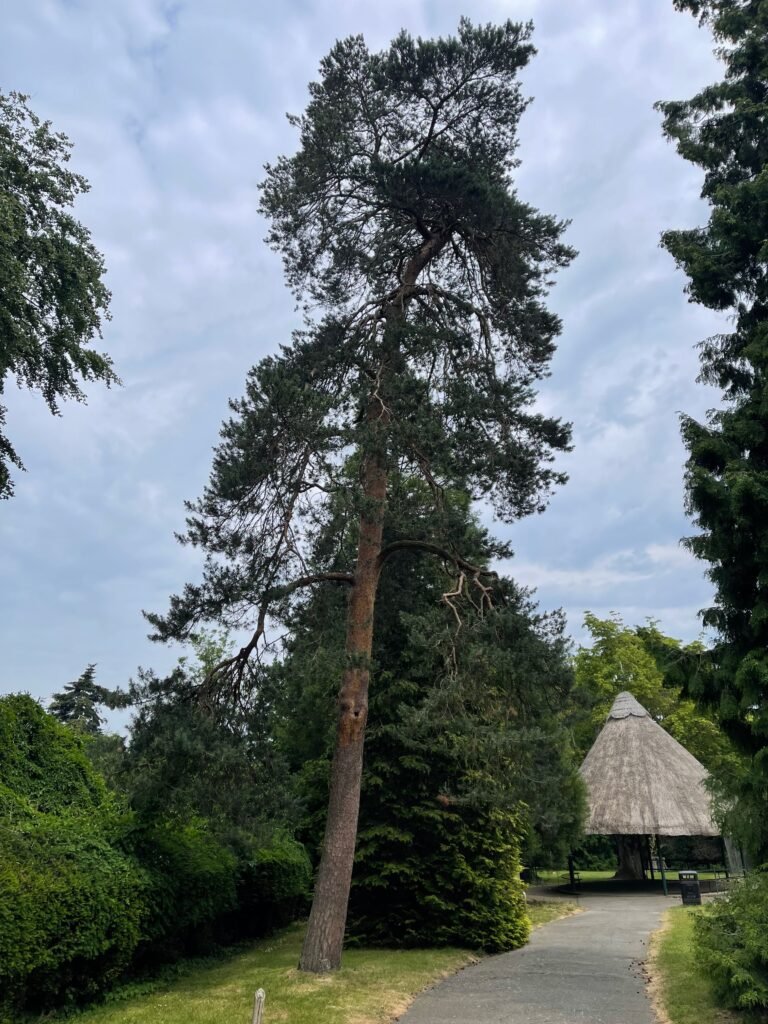Pine, Scots
The Scots Pine (UK), Scotch Pine (US), is a truly stunning evergreen conifer, that can grow to a height of 35m, and may live for 700 years.
A tall straight pine tree. The scaly bark is istinctive orange-brown, which develops plates and fissures with age. Twigs are green-brown and hairless.

Photo supplied by: Alan Payne
Common Name:
Scots Pine
Scentific Name:
Pinus sylvestris
Tree No:
78
Location:
C11

The needle-like leaves are blue-green and slightly twisted, and grow in pairs on short side shoots.

Credit: This could be your image
Scots pine is monoecious, meaning both male and female flowers grow on the same tree. Male flowers comprise clusters of yellow anthers at the base of shoots. Female flowers are small, red-purple and globular, and grow at the tips of new shoots.

Credit: This could be your image
After pollination by wind, the female flowers turn green and develop into cones. They mature the following season, so there are always cones of different ages on the one tree. Mature cones are grey-brown with a raised, circular bump at the centre of each scale.

Credit: This could be your image
Scots pine is the only truly native pine in the UK. It thrives in heathland and is widely planted for timber, but is also found in abundance in the Caledonian pine forest in the Scottish Highlands.
The Caledonian forest is a priority habitat under the UK Biodiversity Action Plan and is home to many rare species. Mammals include red squirrel, pine marten and Scottish wildcat. Scots pines in southern England are also the main caterpillar foodplant for the pine hawk-moth.
When used for commercial production of timber rotations of 50 to 120 years are normal. Its valuable timber is used for wood pulp and sawn timber.
Scots pine timber is one of the strongest softwoods available and is widely used in the construction industry for joinery. It is used in the manufacture of telegraph poles, pit props, gate posts and fencing. The tree can also be tapped for resin to make turpentine. Other uses have included rope made from the inner bark, tar from the roots and a dye from the cones. Dry cones can be used as kindling for fires.
Optional Content.
Tree Listings
Wild Cherry
Cherry, Wild The Wild Cherry, one of the prettiest native trees, is a broadleaved deciduous tree, that can grow to a height of 30m, and may live for 60 years. The shiny bark is a deep reddish-brown with prominent cream-coloured horizontal lines called lenticels. ...
Western Red Cedar
Cedar, Western Rad The Western Red Cedar, is an giant evergreen conifer, that can grow to a height of 65m, and may live for 1,000's of years, with several examples in existance that over 1,500 years old. It is tall and conical in shape, with a broad trunk and dense...
Japanese Red Cedar
Cedar, Japanese Red The Japanese Red Cedar, is an evergreen conifer, that can grow to a height of 65m, and may live for 350 years. The bark is grey and stringy and tears off in long strips on mature trees..Photo supplied by:Common Name:Japanese Red Cedar Scentific...
Deodar Cedar
Cedar, Deodar The Deodar Cedar, is a fine textured evergreen conifer, that can grow to a height of 50m, and may live for 1,000 years.These two Deodars were probably planted well before the Gardens opened in 1888.Photo supplied by:Common Name:Deodar Cedar Scentific...
Blue Atlas Cedar
Cedar, Blue Atlas The Blue Atlas Cedar, is a showy evergreen conifer, that can grow to a height of 35m, and may live for 150 years. The trees are pyramidical while young but with age become flat topped with horizontal branches. The bark is blackish-brown with closely...
Silver Birch
Birch, Silver The Silver birch, is a striking broadleaved deciduous tree, that can grow to a height of 30m, and may live for 150 years, although 60 to 90 years may be more typical. Forming a light canopy with elegant drooping branches. The silver-white bark sheds...
Cut Leaf Beech
Beech, Cut Leaf Content to follow. Photo supplied by: Alan PayneCommon Name:Cut Leaf Beech Scentific Name:Fagus sylvatica heterophylla asplenifoliar Tree No:186 Location:D7Content to follow. Credit: This could be your image Content to follow....
Copper Beech
Beech, Copper The Copper beech, also known as purple beech, is a broadleaved deciduous tree, that can grow to a height of more than 40m, and may live for 300 years, although 200 years may be more typical. The bark is smooth, thin and grey, often with slight horizontal...
Common Beech
Beech, Common The Common Beech, is a charismatic and beautiful broadleaved deciduous tree, that can grow to a height of more than 40m, and may live for 350 years, although 250 years may be more typical. The bark is smooth, thin and grey, often with slight horizontal...
Common Ash
Ash, Common The Common Ash, is a broadleaved deciduous tree, that can grow to a height of 35m, and may live for 350 years, although 200 years may be more typical.Tall and graceful, they often grow together, forming a domed canopy. The bark is pale grey-brown and...
Crab Apple
Apple, Crab The Crab Apple Tree, one of the ancestors of the cultivated apple, is a broadleaved deciduous tree, that can grow to a height of 12 m, and may live for 100 years.They have an irregular rounded shape and a wide spreading canopy. With greyish brown flecked...
Auto Draft
Page Title Overview text Diffent points following a single enter.Photo supplied by:Common Name:Xxx Scentific Name:Xxx Tree No:00 Location:X0Content to follow. Credit: This could be your image Content to follow. Credit: This could be your image...
Braintree & Bocking Public Gardens,
43 Bocking End,
Braintree,
CM7 9AE.
Open 9:00 to 4:00pm – January, February.
Open 9:00 to 6:00pm – March.
Open 9:00 to 7:00pm – April.
Open 9:00 to 8:00pm – May, June, July, August.
Open 9:00 to 7:00pm – September.
Open 9:00 to 6:00pm – October.
Open 9:00 to 4:00pm – November December.
Note – The gates are locked at dusk.
Dusk is subject to seasonal variation, so closing times may not be exactly to the schedule, at the transitions.
No dogs allowed in the gardens.
No alcohol to be consumed in the gardens.
No riding of cycles or scooters in the gardens.
General Enquiries
Phone: 01376 773066
Email: info@braintreeandbockinggardens.co.uk
Tennis Enquiries
Phone: 01376 773070
Email: tennis@braintreeandbockinggardens.co.uk
© Braintree & Bocking Public Gardens Trust 2017-2021. All Rights Reserved.
Registered Charity Number 212989
Get in touch


Braintree and Bocking Public Gardens
We provide, maintain and preserve these unique and beautiful gardens as a community green space.